WebDev
I'm a React developer. I have a few personal projects
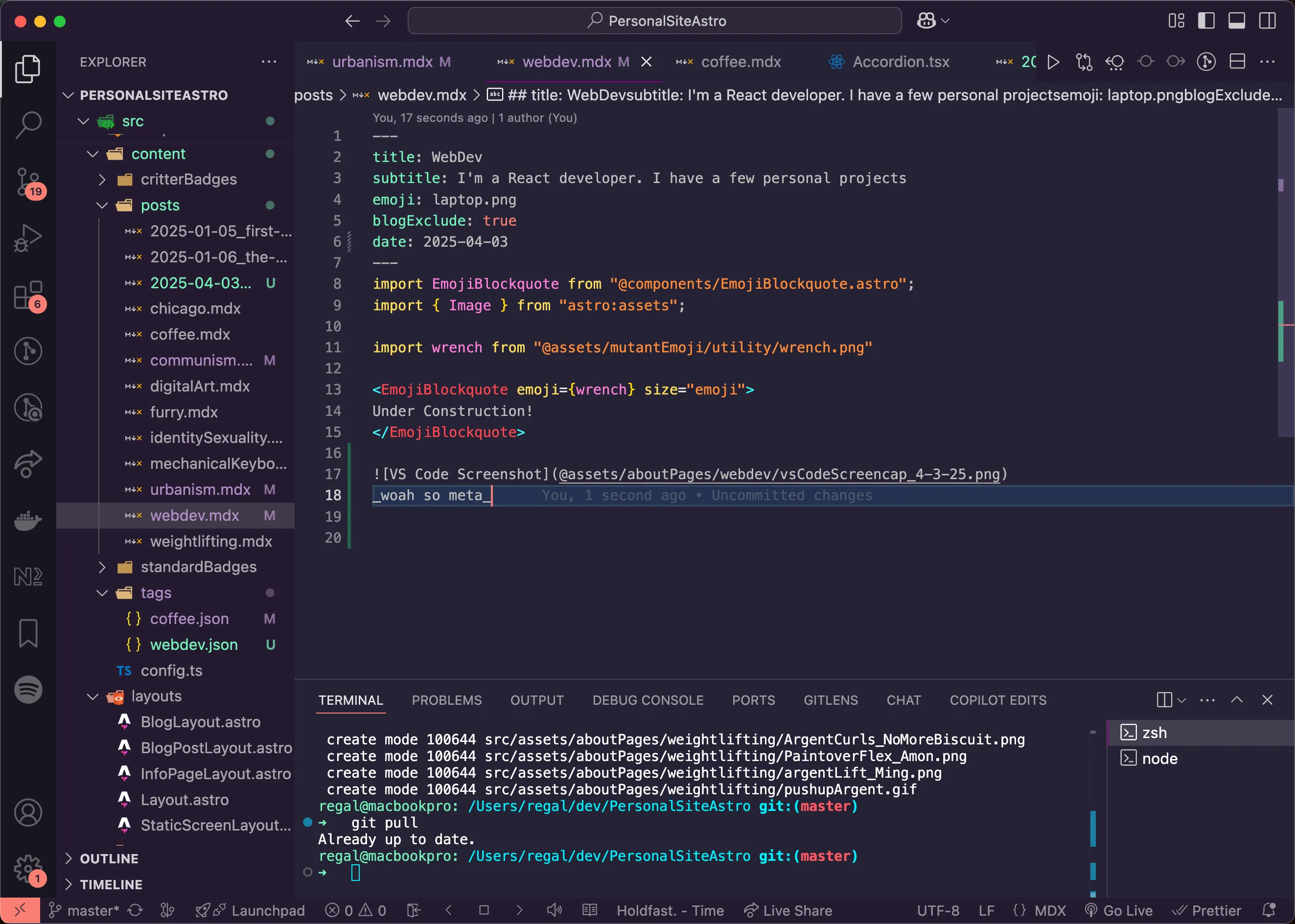 woah so meta
woah so meta
WebDev is a weird one for me because it’s definitely something I’m passionate about, but it’s also my *job*. I’m pretty confident that aside from blog posts and random updates to this site, I won’t have any notable projects to talk about as I’ll shift back to my other hobbies (especially drawing).
Brief Glossary for Non-Developers
In lieu of a Marx and Engels-length footnotes section, I’m just going to frontload a few terms for anyone who isn’t in da biz.
General Terms
- Frontend/Backend - General terms of convenience for talking about what part of a website/application/system someone or something touches.
-
- Frontend - What the end-user sees. This is the “Website” as you see and interact with it. It has visual designs, and if it’s running on a browser, it is 100% HTML, CSS, and Javascript at that point. Python, Javascript, and PHP are examples of Front-end coding languages.
-
- Backend - Boiled down, this is “server stuff”. It’s the part of the app that takes information from the Front, and processes it to interact with servers. C++, Java, and C# are examples of Backend coding languages.
- Framework - This refers to a “library” or some other package of code that wraps around a coding language. React is a Javascript Framework, for example. Django is one for Python, and Laravel for PHP. Frameworks give new tools and convenience to developers while ultimately compiling back down into that simple language
Languages
- HTML - “Hypertext Markup Language”, the bones of websites. If you see things written in tags
<p>Like This</p>you’re probably looking at HTML - CSS - “Cascading Style Sheets” is how you style HTML to make text bigger, add colors, do animations…everything! It’s pretty cool but a little bit clunky.
- Javascript - Named “Javascript” specifically to benefit from the market share popularity of “Java” (they are otherwise unrelated). It’s the ✨browser magic✨ language that lets you do fancy things like “remember my login” and complex animations and movement. Mostly it’s notable for allowing an app to take input from the Website or Frontend and pass it back to the backend for more processing and fancy logic.
My Specialties/Faves
If this were a resume I’d list off a whole bunch of things b/c as a “full-stack” developer, I’m at least *competant* at most every design language. But as a hobby (and when I have a choice professionally), these are my tools of the trade.
React & Angular
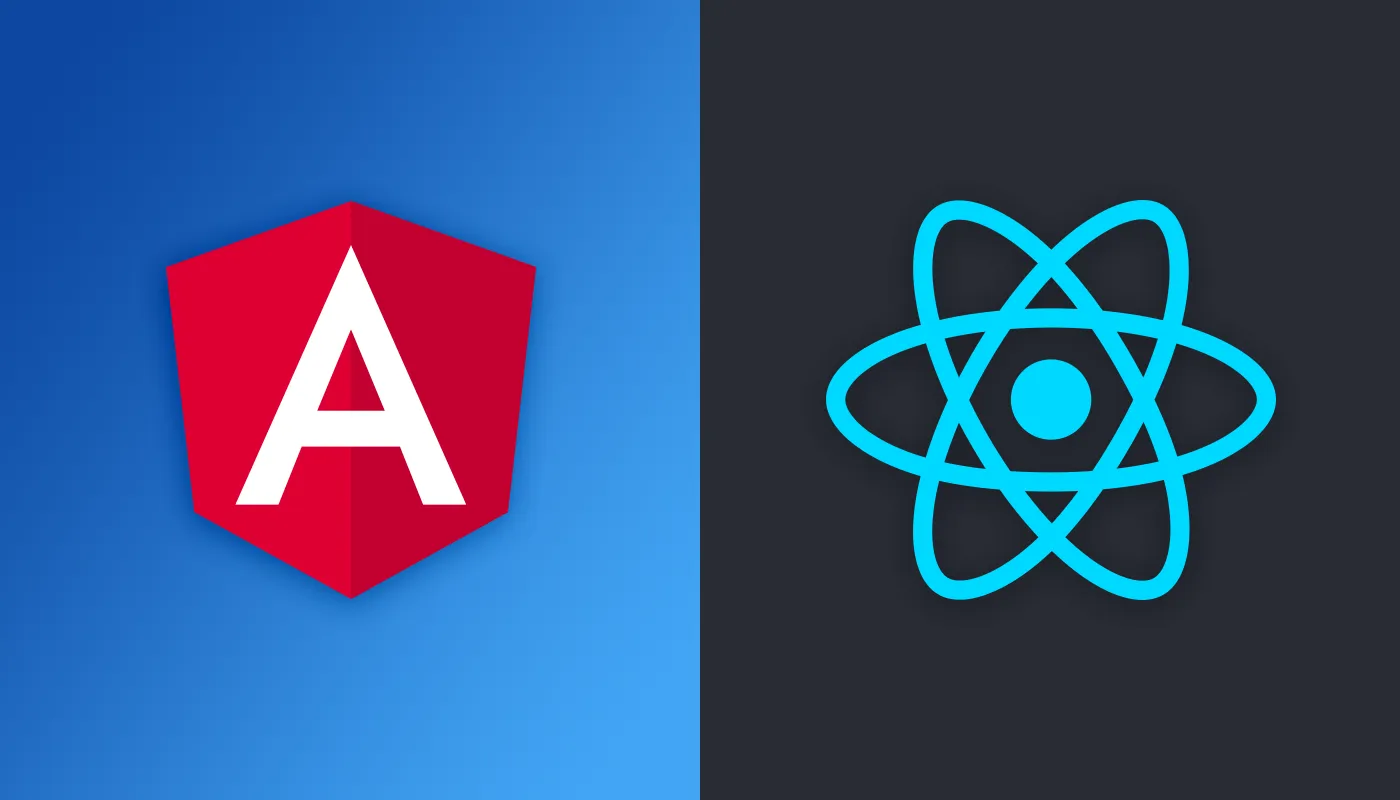 I started with Angular, learning at work, and then taught myself React doing some side projects. Nowadays I prefer React (partly because it’s the most popular professionally), but the design philosophies carry over pretty well. They’re both very opinionated, but I think I’m a better React developer because I started as an Angular developer.
I started with Angular, learning at work, and then taught myself React doing some side projects. Nowadays I prefer React (partly because it’s the most popular professionally), but the design philosophies carry over pretty well. They’re both very opinionated, but I think I’m a better React developer because I started as an Angular developer.
Design Philosophy
Angular design encourages a stricter organization structure with a preference towards many small, simple components rather than larger, complex ones. Many React projects I’ve started on have been pretty bloated by comparison. Because components start as Javascript and then take in HTML for page rendering, devs tend to keep packing in HTML without considering separating things out.
Object-Oriented -> Components
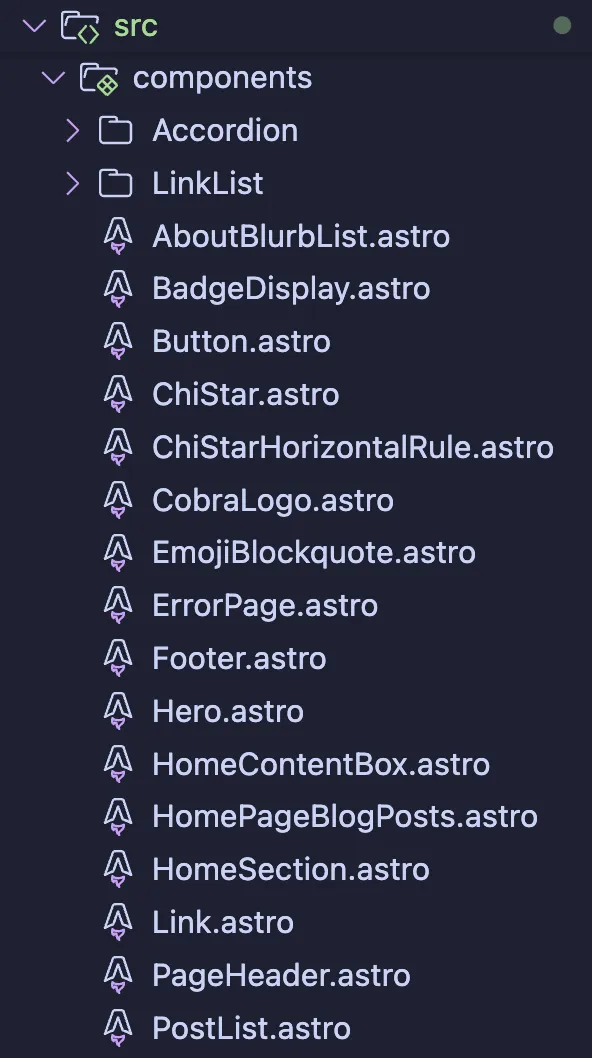 Components folder for this website
Components folder for this website
Object-Oriented Programming is probably the coding concept that clicked with me the strongest. Treating things as Objects that can Do things and have things Done to them just makes a lot of sense.
Component-Driven Design takes that a step further and encourages compartmentalisation of functionality. It looks more organized, and means that to change the design or function of something on your project, you only have to change it in one spot.
Basically: “Will you use the same thing more than once? Make it a reusable component!”
HTML, CSS, and TailwindCSS
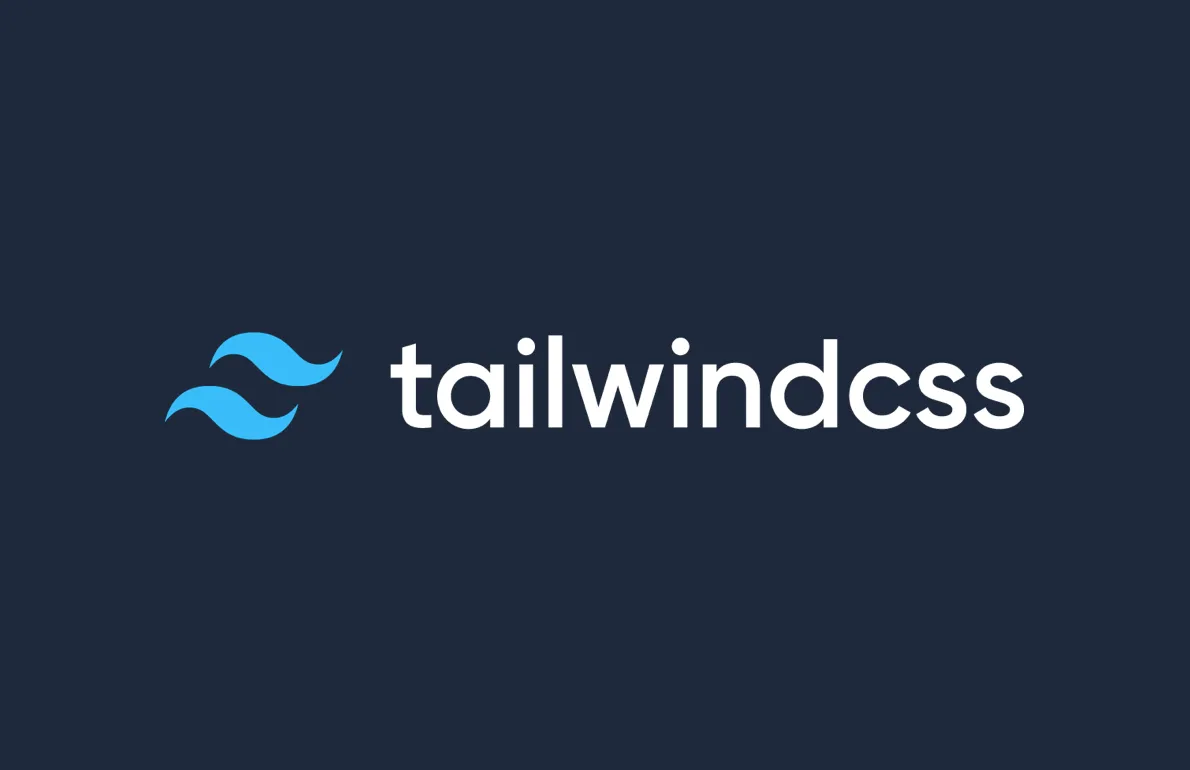 I really like classic HTML/CSS development. My previous “professional” site was made with 99% vanilla HTML and CSS just to see if I could. But I included Tailwind (new as of this website) because with component-driven development it just makes life so much easier.
I really like classic HTML/CSS development. My previous “professional” site was made with 99% vanilla HTML and CSS just to see if I could. But I included Tailwind (new as of this website) because with component-driven development it just makes life so much easier.
I first learned HTML on tumblr by customizing my personal blog theme there. It’s a pretty intuitive and simple language. I feel pretty comfortable recommending it as a good starting point for someone interested in “learning to code”.
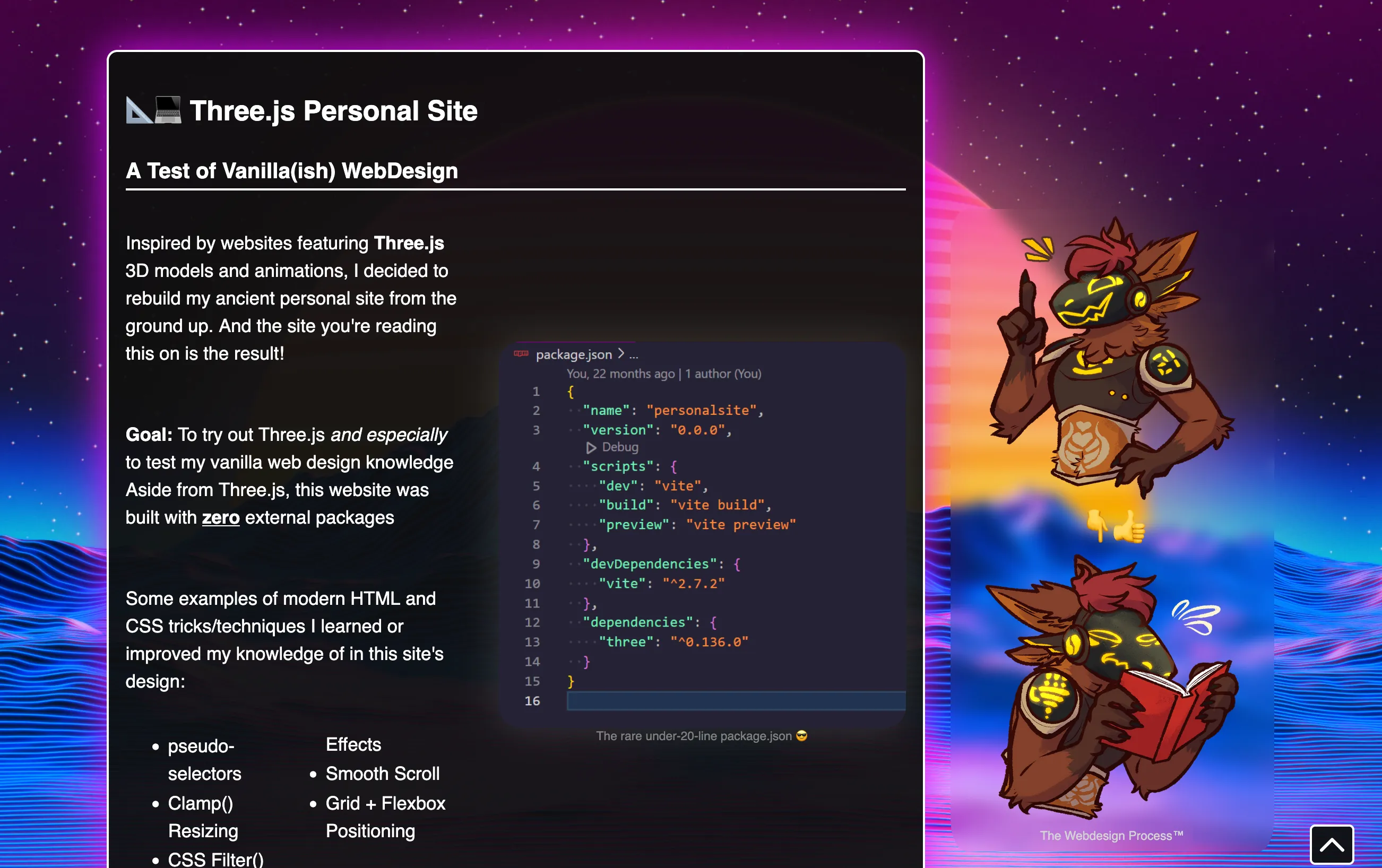 Screenshot of my old professional website
Screenshot of my old professional website
AstroJS
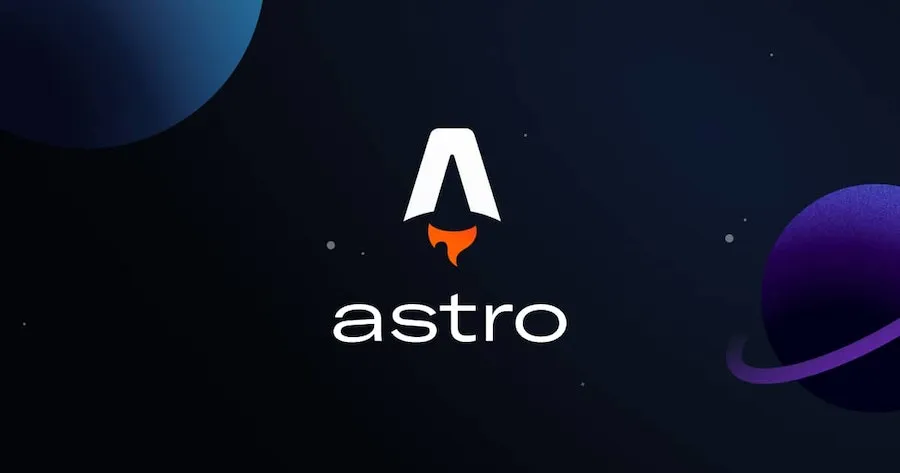 This is new! It’s what this website is made with. I’m instantly a big fan–gives you all that freedom of ReactJS without the bloat of irresistable state logic silliness.
This is new! It’s what this website is made with. I’m instantly a big fan–gives you all that freedom of ReactJS without the bloat of irresistable state logic silliness.
Is It Fun Though
Even though it’s what I do professionally, I’d still call webdev a hobby. Especially doing frontend design projects like this website. It’s a creative exercise with a logical underpinning, and that’s cool.
I’d say the biggest downside is that it’s hard to enjoy with friends. Aside from the finished product, there isn’t a lot here to share or *do* with friends.
The Appeal
The overall appeal of WebDev for me is the combination of Creative + Problem Solving aspects. It’s just super cool typing out logical things and having it output into something artistic or at least “cool looking”. That feels powerful.
I’m very pleased with this website, for example, for automating a lot of my text. This page is a Blog Post template file that translates Markdown into both nicely-formatted text and autogenerates a Table of Contents with links! That’s so cool.
As an example, this is the code that takes in headers from my blog post files, processes it, and formats it into the table of contents on the side:
---
import type { MarkdownHeading } from "astro";
import TextDeco from "./TextDeco.astro";
import ChiStar from "@components/ImageComponents/ChiStar.astro";
interface Props {
headings: MarkdownHeading[];
}
const { headings } = Astro.props;
const filteredHeadings = headings.filter((heading) => heading.text !== "Footnotes");
---
<nav class="sticky top-0 pt-4">
<h3 class="text-3xl font-medium mb-2">Contents</h3>
<ul>
{
filteredHeadings.map((heading, i) => {
if (heading.depth > 1) {
return (
<li>
<TextDeco url={`#${heading.slug}`}>
<span class="text-sm">
{[...Array(heading.depth - 1)].map(() => (
<ChiStar />
))}
</span>
<span class="text-wrap">{heading.text}</span>
</TextDeco>
</li>
);
}
return (
<div class:list={[" w-[75%] bg-slate-200/30 p-0.5 mb-1.5", `${i===0 ? 'hidden' :'inline-block'}`]}></div>
<li>
<TextDeco url={`#${heading.slug}`}>{heading.text}</TextDeco>
</li>
);
})
}
</ul>
</nav>The Job
In my 7+ years of professional software dev work I’ve definitely had good days or even weeks where I’ve been excited about my work, but I’ve never been truly passionate about it. Maybe it’s just the communist in me but as a wage-worker I’ve never been fully compensated for the work I’ve done on products I’ve never cared for beyond the paycheque.
2017 Origins
Folks are often amused and confused when I tell them that my bachelors are in Biology and Religious Studies. Turns out there isn’t a lot of work for those!
While living in Seattle and working a very disappointing office job, I spent my freetime learning how to code.
Just like the tech bros said I should! 🙃
I tried to learn Python but hated it so much. Starting at 0, a loose scripting language where you need to read whitespace was just so unintuitive for me. I ended up starting with C# instead–s/o to university night class certificate programs!

Since earning that C# certificate I have never once coded in C# lmao. I got hired for it, then ended up doing Java instead (since they’re nearly the same) and just never went back. Oh well!
Backend to Frontend
The rest of my “story” isn’t all that interesting. I spent a few years doing Java1 development for a company, and then had the opportunity to switch projects and do Angular2. I really liked Angular, and enjoyed that project!
In my free time at home I taught myself React3 specifically because I kept hearing how “hot” it was as a job skill. Turned out I liked it a lot too.
Footnotes
-
Java is a very old + generally stable coding language. Today it is almost-exclusively used for “backend” things like handling user interactions with servers. Java and Javascript are not the same thing. ↩
-
Angular is Google’s Javascript framework. Its key feature is allowing Javascript code directly inside of HTML. ↩
-
React is Facebook’s Javascript framework. It’s kind of the opposite of Angular in that it encourages you to code HTML inside of Javascript. ↩
Hi, I'm Regal!

I'm a communist cobra obsessed with coffee, weightlifting, and Chicago!  This is my personal site where I blog about coffee shops and other things.
This is my personal site where I blog about coffee shops and other things. 
Thanks for stopping by! Hit me up on the socials if you have any comments or want to say hi, or if you've
got any cool coffee shop suggestions here in Chicago 